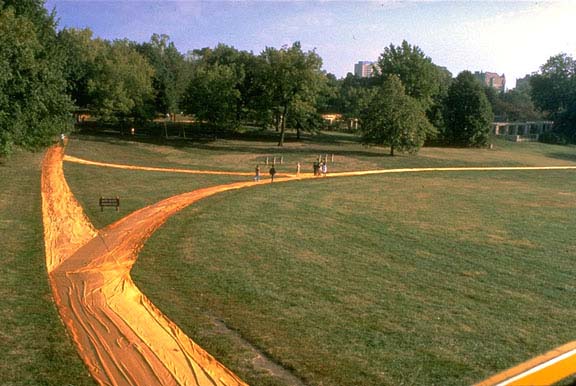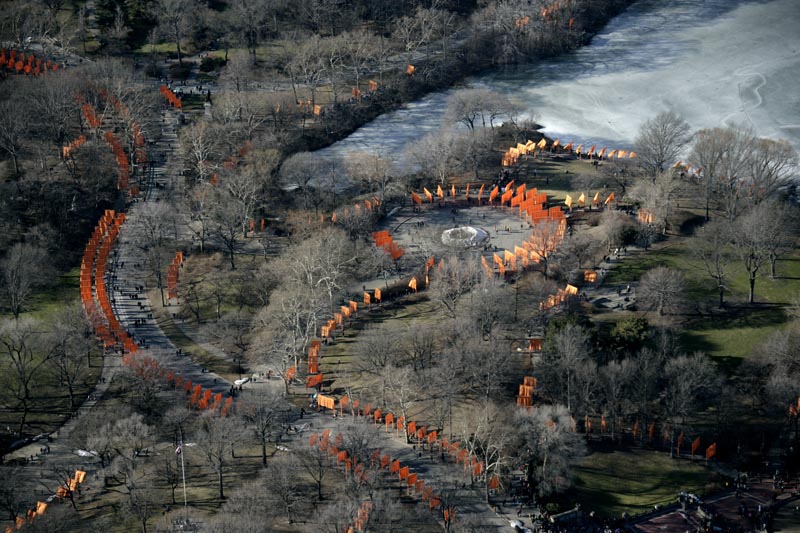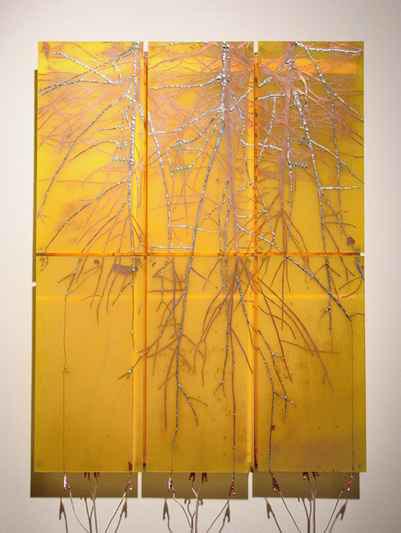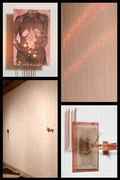art.308:sculpture studio
hannah piper burns
project 2: kinetics and interactivity
artist research
Christo and Jeanne-Claude, Claire Watkins
The collaborative works of Christo and Jeanne-Claude engage the viewer aggressively through their sheer monumentality, or as the artists refer to it, environmentality. The scale of their pieces seems to be a major factor in the actual level on interaction that occurs. For example, Pieces like their newly installed “The Gates” and their “Pont Neuf Wrapped” (1975-85) physically engage the viewer because he or she must walk on or through the work. In the case of “Pont Neuf Wrapped”, people that took boats under the bridge also directly interacted with the work. Their ‘wrapped Walk Ways” (1977-78), which was installed in Kansas City, Missouri, was interactive in that joggers and other visitors to Jacob Loose Memorial Park would walk on it were they to use the walkways. “The Gates’, which is located in Central Park, is installed so that visitors to the park pass through the sixteen foot gates, one every twelve feet, as they traverse the walkways. Larger pieces such as “Valley Curtain” (1970-72), which has a maximum height of 111 meters, are not accessible on the same intimate level, but they dramatically alter the landscape and deeply impacts how it is perceived and responded to. “Valley Curtain” shares some similarities in this respect to Serra’s “Tilted Arc” in that they both re-imagine an environment and the spaces and movement within it. The pieces also share a formal similarity- both use a curve to accomplish their goal. However, Serra’s piece is on the scale of “The Gates” in that it forces interaction on an immediate physical level rather than just a largely visual one. Also, it was meant to be a permanent installation, while “Valley Curtain”, as well as all works by Christo and Jeanne-Claude, was temporary, with its removal restoring the site to its original condition. This aspect of Christo and Jeanne-Claude’s work reinforces the notion that their installations are about engaging others in a fantasy, inviting viewers to imagine a different world, a world ordered to the liking of their aesthetic, Although the artists claim that their work is for their personal engagement and not designed specifically for others to enjoy, the size, bright colors, and dissonant appearance of the projects necessitates a reaction from the viewer, whether positive or negative.
Claire Watkins’ kinetic sculptures feature movements that echo
the workings of the human body and brain. For “Dendrites”
and another piece she showed in class that was a memory map of all the
people she remembered in her life, she used tree branches and lights,
two objects that are linked symbolically to mental processes. In fact,
the word “dendrites” has its root for the Greek word for tree,
and also refers to parts of a neuron. However, one usually associates
the movement of brain signals with incredible speed, while the kinetic
elements of Watkins’ sculptures move slowly and gracefully. In “Dendrites”
the movement might be completely imperceptible if viewers could not see
the shadows cast by the branches changing shape. In her memory map piece,
Watkins positioned the LEDs so that each light represents a person. When
a piece of a circuit board is touched, different lights go on. This engages
the viewer in a recreation of the process of remembering, making mental
connections. “Fireflies” also utilizes LEDs, but to reference
a very different part of the body and are much more metaphorical than
literal interpretation.of a Rotating brushes connect circuits on a circuit
board that control the lights, which are imbedded in an image of a torso,
in the stomach area. The insectoid twinkling of the lights and the hands
in the image, which are holding the stomach, visually call to mind the
phrase “butterflies in the stomach”. The insect imagery is
repeated somewhat in “Feathers”, in which single strands of
peacock feathers are put in groups of three, hinged together, and attached
to the wall. Motors cause the strands to move slowly so that they take
on the appearance of thin legs crawling up the wall. “Needles”,
like “Fireflies”, features a torso full of moving parts, but
they are needles, not lights, and their movement is augmented by the amplification
of the sound they make. In this piece the torso is three-dimensional,
giving the viewer the feeling of actually peering into a body and viewing
the internal action taking place. Needles and the sound they make also
causes a very visceral recognition in the viewer, especially when the
needles are positioned inside a body form.
Watkins mentioned in class that the movements of her sculptures are meant
to be gradual and subtle, so that viewers are compelled to take a second
or third look at the works as a change is perceived over time. The materials
with which she works also facilitate a slow speed, as the movements (twinkling
lights, the pirouettes of magnetic filings, feathers against a surface)
have an inherent grace that is maximized at a slower speed.
St. Mary's College of Maryland
St. Mary's City MD 20686-3001
Back to Index
This page was last updated: March 28, 2005 4:35 PM






